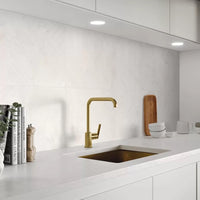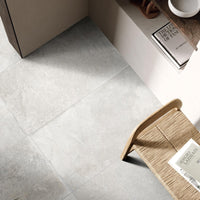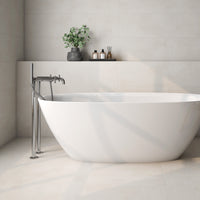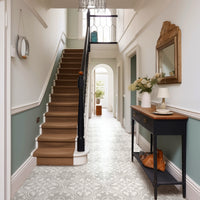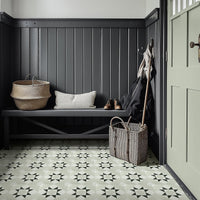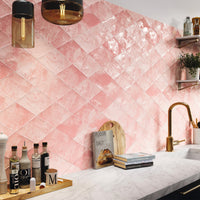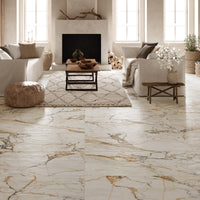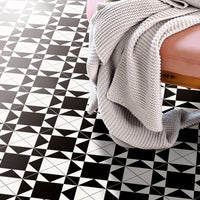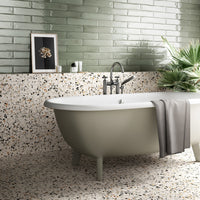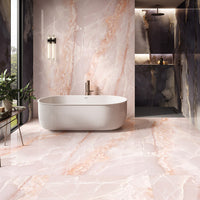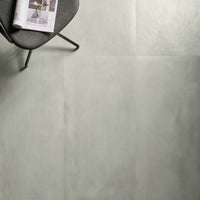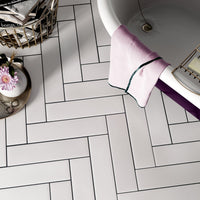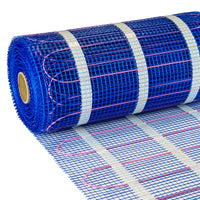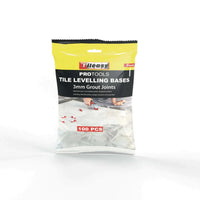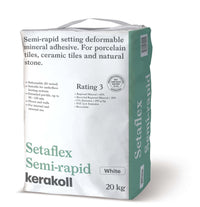This guide will help you discover everything you need to know about Outdoor Tiles, from choosing the right design through to installation and aftercare.
Although us Brits have always been proud of our gardens, the trend for outdoor living has really taken off in the last few years. Post pandemic, we now see our backyards and lawns as a room in their own right - whether that's for eating, entertaining or a place to simply sit and relax in.
And as the nation’s need for creating practical, yet stylish, external spaces has grown, so too has demand for patios that deliver both function and form. That's where outdoor tiles come in.

What are outdoor tiles?
When we talk about outdoor tiles, we’re referring to 20mm thick porcelain tiles that are specifically designed to be laid outside.
At double the thickness of normal indoor tiles, these outdoor tiles are extremely hard and long-lasting, able to withstand pretty much anything you - or the elements - can throw at them.
Also known as porcelain pavers or slabs, these tiles offer many advantages over traditional flooring materials such as timber decking or Indian sandstones, which we’ll look at shortly. They’re available in a whole host of designs and styles, can be installed in a variety of ways and are generally much kinder to the environment.
Little wonder, then, that they’ve become the number one flooring choice in a just a couple of years.
What are the benefits of outdoor tiles?
Outdoor tiles are truly revolutionary and a must have for your garden. Not only are they incredibly durable, they’re also virtually non-porous - an important consideration given our wet weather.
Let’s take a closer look at the features of outdoor porcelain tiles, and how they’ll benefit you and your home.
-
Because of their dense structure, they’re extremely hard-wearing and highly resistant to wear, tear or scratching. They’ll still look fantastic in years to come - even if laid in an exposed spot outside or over a busy terrace. They’re unlikely to chip or wear away, even after years of busy footfall or garden furniture being dragged over them.
-
As they are made from porcelain, they are very difficult to stain and won’t discolour over the years due to bad weather. This means they're low maintenance and much easier to live with than other flooring options. Moss and algae can quickly be cleared off the surface, helping you keep your space safe and looking its best.
-
Outdoor tiles are completely weatherproof and won’t deteriorate in extreme conditions. Because they’re non-porous, water is unable to penetrate into the tile so they won’t crack in colder weather. And at the other end of the weather spectrum, our outdoor tiles are resistant to UV light and won’t fade when exposed to bright sunshine.
-
Unlike traditional decking - which can be lethal when it’s wet - our outdoor tiles are designed with safety in mind. They all feature a slip rating of R11 or higher, giving you great levels of grip underfoot; not to mention peace of mind.
-
And last but not least, our outdoor tiles are beautiful to look at and come in a variety of colours and styles, from classic buff to contemporary grey. So say goodbye to gloomy, boring gardens - with our vibrant designs, your outdoor space will look just as eye-catching as the inside of your home.
Like to know more? This handy guide compares outdoor tiles to other popular outdoor materials.
Where can outdoor tiles be laid?
One of the great advantages of outdoor tiles is how versatile they are. Their strength and durability means they can be laid almost anywhere outside, opening up a whole new world of design possibilities. Here's some of our favourite places to lay outdoor tiles:
-
Thanks to their beautiful designs, you can use our outdoor pavers to create stylish patios and terraces, for the perfect alfresco living space.
-
Lucky enough to enjoy a swimming pool or hot tub at home? Outdoor tiles can be used to create a stunning surround that's smart, safe and slip-resistant, too.
-
Add a unique touch to your lawn by using heavy porcelain pavers to create stepping stones and paths.
-
When installed onto a concrete screed, 20mm tiles can be used to design attractive driveways that will take the weight of cars.
-
As they are so durable, outdoor tiles are also perfectly suited to heavy duty applications such as public squares and restaurant terraces.

What styles of outdoor tiles are available?
Aside from the safety factor, the main reason why outdoor tiles are so popular is the amount of stunning designs on offer. Whether your style is traditional or contemporary, there's likely to be a tile that's perfect for you. Here's a quick look at what you can find:
-
Porcelain pavers such as Kandla Grey 2CM, that are faithful replicas of traditional Indian sandstones
-
Wood-look slabs such as Ascot Oak 2CM, that offer the timeless character of timber decking but won't rot or fade away
-
Stone-style tiles with all the warmth and charm of natural limestone or slate, without the expense or upkeep
-
Designs inspired by contemporary materials such as polished concrete or resin
And that's not all. In addition, outdoor porcelain tiles are also available in other finishes that you wouldn't normally expect to find outside.
For example, with our Ethos Carrara slabs, you can enjoy the beauty of white marble outside. While these look just like the lavish natural marble, they won't stain or decay due to bad weather - and they won't break the bank, either.
What sizes of outdoor tiles are available?
When outdoor tiles were first introduced a few years ago, the main size on offer was 60 x 60 cm. And while these slabs are still incredibly popular, many more sizes are available today.
-
Flagstone tiles are ideal for all manner of spaces, from small back yards to larger patios. They traditionally measure 60 x 90 cm and are often laid with a staggered grout joint.
-
Larger slabs including 60 x 120 cm and 90 x 90 cm will offer a truly contemporary aesthetic that no other outdoor materials can match. We recommend laying with a small grout joint, for a seamless finish.
-
As mentioned before, 60 x 60 cm tiles are a very popular choice for all manner of properties, thanks to their versatility. Not only do they look great just about anywhere, they're also ideal if you're planning to install your new outdoor tiles yourself.
-
Other exciting sizes include smaller cobbles - perfect for small paths and features - and larger 'opus style' designs, where different sized tiles are combined to form a stunning feature layout.

How much do outdoor tiles cost?
As a guide, you should expect to pay between £35 and £60 per square metre for your outdoor tiles. Anything lower than this could ring alarm bells around quality; anything higher and it's likely you're paying for inflated margins.
Outdoor tiles tend to be a little more expensive than their indoor counterparts, for two main reasons.
-
Firstly, because they're double the thickness, they use double the amount of raw materials to produce. They also need to be fired for longer in kilns, which is an energy-intensive process.
-
And secondly, shipping from the factory into the UK is more expensive, as these slab tiles are heavier than traditional tiles.
However, on a like-for-like basis you'll find that outdoor tiles compare extremely favourably to natural stone pavers and the like.
These tend to be more expensive to buy and maintain, before you even begin to consider the lifetime cost. Remember that your new outdoor porcelain tiles shouldn't deteriorate over time, if they're correctly maintained.
How to choose the right outdoor tiles
As with our interiors, personal preference plays a huge part when it comes to choosing outdoor tiles.
For example, if you're creating a modern outdoor space then it's likely you'll prefer a neutral grey design, rather than a traditional flagstone paver with chipped edges.
So first and foremost, consider the overall look you're after, to really help narrow down your tile choice. Are you looking to develop a Mediterranean courtyard, an achingly-cool space to entertain or simply a relaxing patio to enjoy with the family?
If you're not entirely sure yet, we'd recommend browsing Pinterest or your favourite interiors magazine, to see how other people have styled their space.
Once you've settled on the style you'd like to achieve, there's a few other things to consider:
-
As well as the aesthetic, the size of an outdoor tile will help define the look and feel of your new outdoor space. Smaller tiles are great for adding interest to back yards, while larger slabs will convey a sense of space and always offer the coveted wow effect.
-
It's always a good idea to order a sample tile first. While some outdoor tiles have a slightly gritty or riven surface for texture, others actually feel smooth, while still achieving a certified slip rating. If you'll be walking around barefoot, you may want to think about how the surface will feel underfoot.
-
Many outdoor tiles have rectified edges, so they can be laid close together for an ultra-modern finish. However, some tiles are un-rectified and need to be laid with a larger grout joint, while others have deliberately tumbled edges and offer a more rustic, traditional finish.
-
In a similar vein, it's a good idea to consider the grout joint before choosing your tiles, as it can have such an impact on your space. For example, using a smaller joint and a matching grout will help you craft a seamless patio, while larger joints or contrasting grout colours can add interest and definition to your back yard.
And finally, when you're weighing up the costs of different tiling options, don't forget to include the cost of fixing materials and labour into your budget.
It's very difficult to put a figure on what this could be, as it depends on how much preparation is required and your exact installation method, which we'll look at shortly.
How to create a seamless indoor-outdoor space
In recent years, our gardens have truly become an extension of our homes. And a huge trend - especially if you have a large garden room or kitchen extension - is to incorporate bi-fold or sliding patio doors. This way, you can open up your home to the great outdoors, and enjoy a dreamy alfresco lifestyle.
And the key to nailing the link between your indoor and outdoor spaces? Outdoor tiles. Many ranges feature a matching indoor tile that's around 10mm thick with a smooth surface. This means you can essentially continue the same tile from your indoors to outdoors, blurring the boundaries and creating a huge sense of space.
We recommend keeping the level of your internal and external floors as close as possible, to really help the whole space feel cohesive.

How to measure for outdoor tiles
Measuring for outdoor tiles is pretty straightforward. You'll just need a tape measure, pencil and paper and a calculator - unless you're very good at maths!
- Use the tape to measure the length and depth of the area to be tiled, in metres
- Multiply these on the calculator
- Add an extra 10% to cover for waste and cuts
- For example, if your patio measures 5 x 3 metres, you'll need to order 16.5 square metres of tiles
And that's it, for simple squares and rectangles at least. If your area is an awkward shape, it's best to draw it out on a piece of paper and break the shape down into a series of squares and rectangles.
You can then calculate the area of each shape individually and add them up, to determine the total area you'll need to cover.
How to install outdoor tiles
Aside from their looks and performance, one of the great advantages that porcelain pavers have over traditional stone slabs is the variety of ways in which they can be installed.
Although they're usually fixed in place using tile adhesive or bedding mortar, they can also be laid onto raised pedestals or directly onto grass or gravel. Let's take a closer look at each installation method - for further information, we recommend reading our dedicated guide to installing outdoor tiles.
Concrete slab
If you're constructing a new build property or adding an extension to your home, there's a very good chance you'll have a concrete slab in place for your new patio. Porcelain slabs can be fixed to the slab using a high quality porcelain tile adhesive, in the same way you'd install indoor porcelain tiles.
It's important to make sure the concrete slab is fully cured before tiling and that it slopes away from your property, so rainwater can drain away.
Mortar bed
This is the most popular method of installing outdoor tiles in the UK - especially if you're renovating an existing patio or garden. A sub-base of MOT1 crushed aggregate is prepared and compacted for stability, before the tiles are fitted into place using a sand and cement mortar.
Crucially, a slurry primer must always be applied to the back of the tiles, to help aid the bond between the slabs and the mortar bed.
Pedestals
As porcelain pavers are so tough, they can be laid on top of plastic pedestals without the need for adhesive or grout. Compared to the other methods, these pedestals offer a dry, quick and easy installation - even if you don't have any previous experience.
Popular both for commercial projects and balconies, rainwater will drain through the gaps around the tiles, so you'll need to ensure the sub-floor below has an adequate fall.
Grass or gravel
You can also dry lay porcelain pavers onto grass or gravel, without the need for tile adhesive or mortar. This is popular for DIY installations, especially if you're creating stepping stones across your lawn or a new path through your yard.
Rather than laying the slabs directly onto grass, we recommend digging a hole that's the size of each tile and filling the base with compacted gravel. This will offer a more stable base for the tiles.
Initial clean
It's imperative that your outdoor tiles are given a thorough clean immediately after they're installed, especially if adhesive, grout or jointing compounds are used. Otherwise, a fine layer of cement can stick to the texture on the surface of the tiles, attracting dust and causing your new patio to look dirty all the time.
Strictly speaking, outdoor tiles don't need to be sealed. However, you can apply our LTP Porcelain Tile Protector to your new patio before and after it's grouted. This sealer will help ensure that any grout or jointing compound residue doesn't stick to the tiles and detract from their appearance.
How to cut outdoor tiles
Because they're so dense, outdoor tiles can't be cut using a normal tile cutter. And while in theory you can use a powered cut-off saw or angle grinder with the correct blade, we always recommend using a wet tile cutter.
As you might expect, there's wet tile cutters and then there's wet tile cutters. For 20mm porcelain, you'll need a high quality bench cutter with a continuous rim diamond blade, that's specially designed for cutting through ultra-tough outdoor porcelain.
Throughout the year, we cut a lot of porcelain pavers into 10 x 10 chips for our free samples. We use the Rubi DCX-250 XPERT cutter together with their SPT Premium blade - they've never let us down, although the blade does need replacing as the diamonds wear away.
How to clean outdoor tiles
You've probably heard that porcelain tiles are low maintenance - and they are, especially when compared to traditional outdoor materials such as decking and natural stone.
However, they will still need a clean from time to time, to keep them looking their best over the long run. Otherwise, fallen leaves, moss, bird droppings and algae can build up on the surface of the tiles, impairing their beauty and reducing grip underfoot.
The good news is that as outdoor tiles are stain resistant, they are very easy to clean, especially with specific cleaning products.
- Sweep away dirt and debris using a yard brush. It's best to do this on a dry day, when any leaves are crispy and won't stick to the tiles!
- Apply a diluted solution of LTP Grimex to your patio tiles and agitate with the yard brush
- Give the solution some time to work, then rinse thoroughly with clean water from a hose pipe
For stubborn stains, you can use a more concentrated solution of Grimex or LTP Black Spot & Algae Remover which, as the name suggests, is also great for attacking moss, lichen and other organic stains.
Please read our guide to cleaning outdoor tiles for further information.
Can I use normal porcelain tiles outside?
While standard thickness porcelain tiles share many of the same characteristics of outdoor porcelain tiles - being frostproof and resistant to fading - we don't advise laying them on patios and terraces outside.
As they're designed for internal use, their slip resistance is unlikely to be high enough for outdoor spaces. This means they may become slippery when it's wet.
However, some normal porcelain tiles do feature grittier or textured surfaces and are intended for external use. In this case, they must always be laid onto a concrete slab using a high performance porcelain tile adhesive. Unlike their thicker cousins, they aren't strong enough to be installed onto pedestals or a mortar bed.
Are outdoor tiles environmentally friendly?
When it comes to investing in our homes, making a decision isn’t solely based on cost and style - these days, sustainability is just as important.
Compared to other materials such as timber decking and Indian sandstone pavers, our outdoor porcelain tiles are much kinder to both to the planet and ourselves, for a number of reasons:
-
They're totally inert and don't contain any toxins or heavy metals, which are a health hazard and can pollute the atmosphere
-
They're produced using abundant raw materials that are commonly found on the surface of the earth
-
Many of our tiles are produced in 'closed loop' factories where almost all waste material and water is reused or recycled
-
They don't need to be sealed or cleaned with chemical products, which can be harmful to aquatic and garden life
-
As they're so durable, they're designed to last a lifetime and won't need to be replaced
Furthermore, all of our porcelain pavers are currently sourced from suppliers in Spain and Italy that we know and trust. We have visited their factories and observed their production lines. They're clean, safe and highly regulated environments to work in - the very opposite of the quarries where other paving materials are sourced from.
Will outdoor tiles crack in colder weather?
One of the huge advantages of outdoor tiles is that there's very little chance they'll crack in colder weather. As porcelain is virtually non-porous, water isn't able to penetrate into the tile and freeze.
On the other hand, traditional ceramic tiles and some natural stones may crack over time. As they are porous, water can get into the body of the tile and freeze, causing it to expand. This may eventually cause the tile or stone paver to crack or come loose from the base underneath.
Can I use outdoor tiles inside my home?
For a variety of reasons, we don't recommend using outdoor tiles internally. As they're much thicker than indoor tiles, they're likely to be too heavy for your subfloor - especially on the suspended timber floors that are common in the UK.
And while their textured surface is a huge plus for outdoor use, it isn't necessarily great for indoor spaces, where a smoother finish is usually preferred.
How are outdoor tiles made?
As we mentioned earlier, outdoor porcelain tiles are produced using raw materials that are found in abundance - feldspar, clay, kaolin and quartz.
Although the production itself is highly advanced, it's actually quite a simple process:
-
The raw materials are crushed and mixed with water to form a slurry. This slurry is pressed and compacted into a mould that's the shape and depth of an individual tile
-
Thanks to enormous pressures in the mould, the slurry forms a biscuit that's hard and almost dry. This biscuit is then passed through a drier to remove any remaining water, before the design of the tile is printed onto the surface, using high definition industrial printing machines
-
The tile then slowly passes through a kiln that's heated to 1200 degrees and undergo vitrification, turning from clay into porcelain. Once cooled, the edges of the tiles may be rectified and polished
-
The slabs are then colour graded, with the same grades being boxed together and palletised, ready for delivery
At various stages of the production process, the tiles are quality checked by cameras; any defective material is removed and crushed, ready to be turned into another tile.
We've covered a lot of information here, but just get in touch if you have any further questions. We'd love to help!
And don't forget - if you're looking for new outdoor tiles, why not check out our range and order some completely free samples today?
